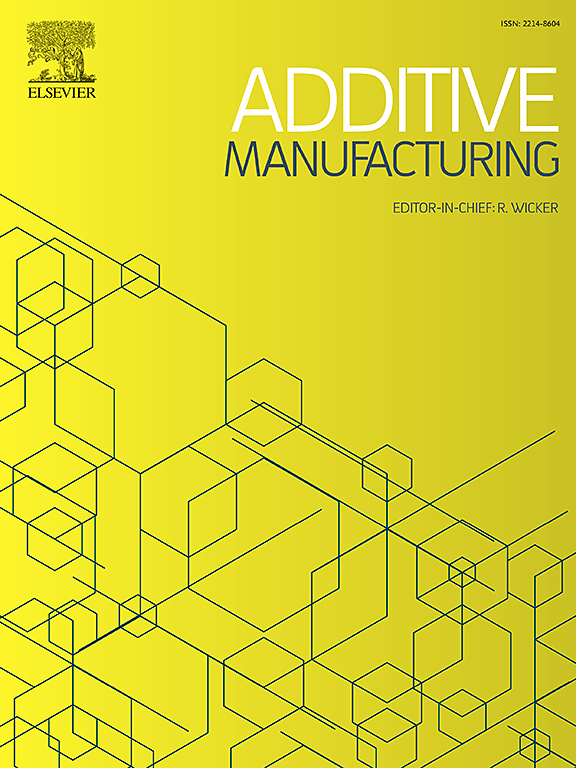Modulated laser thermal interrogation (MLTI): A novel in situ metal powder evaluation technique for laser powder bed fusion
IF 10.3
1区 工程技术
Q1 ENGINEERING, MANUFACTURING
引用次数: 0
Abstract
Assessment of metal powders in powder bed additive manufacturing is crucial, as the quality of the powders significantly impacts the final printed parts. This study introduces a novel technique to characterize metal powders by analyzing changes in their thermal properties, specifically heat capacity and thermal conductivity. The Modulated Laser Thermal Interrogation (MLTI) method utilizes frequency domain responses of temperature to facilitate this characterization. To validate the performance of MLTI, a benchtop setup was made, which identified distinct thermal responses related to various material features, including core material detection, age, oxygen content, and particle size distribution. The powder was heated by a 7 W laser (445 nm) that was modulated at frequencies between 100 Hz and 2 kHz. By capturing the IR emission of the surface with the photodetector and sending the signals to the lock-in amplifier, demodulated amplitude and phase could be extracted which represent the characteristics of the metal powder. We tested common metal powders used in powder bed fusion, such as Cu, AlSi10Mg, SS316L, IN718, and Ti-6Al-4V G5 and G23, to demonstrate the capabilities of the MLTI method. The frequency-domain measurements provided by MLTI offer reduced noise compared to traditional methods. By leveraging machine learning, we could accurately characterize the powder, identify the core material of the powder, determine whether the powder is fresh or reused, assess interstitial oxygen content, verify the powder deposition layer thickness, and analyze particle size distribution. This enhances quality control and process monitoring in powder bed additive manufacturing.
调制激光热探测仪(MLTI):一种新型的激光粉末床熔合原位金属粉末评价技术
粉末床增材制造中金属粉末的评估是至关重要的,因为粉末的质量显著影响最终打印部件。本研究介绍了一种新的技术,通过分析其热性能的变化,特别是热容和导热系数来表征金属粉末。调制激光热探测(MLTI)方法利用温度的频域响应来促进这种表征。为了验证MLTI的性能,进行了一个台式设置,确定了与各种材料特征相关的不同热响应,包括芯材检测、年龄、氧含量和粒度分布。在100 Hz和2 kHz之间调制的7 W(445 nm)激光加热粉末。利用光电探测器捕获表面的红外发射信号,将信号送入锁相放大器,提取出代表金属粉末特征的解调幅度和相位。我们测试了用于粉末床熔合的常见金属粉末,如Cu、AlSi10Mg、SS316L、IN718和Ti-6Al-4V G5和G23,以证明MLTI方法的能力。与传统方法相比,MLTI提供的频域测量降低了噪声。通过机器学习,我们可以准确地表征粉末,识别粉末的核心材料,确定粉末是新鲜的还是重复使用的,评估间隙氧含量,验证粉末沉积层厚度,并分析粒度分布。这增强了粉末床增材制造的质量控制和过程监控。
本文章由计算机程序翻译,如有差异,请以英文原文为准。
求助全文
约1分钟内获得全文
求助全文
来源期刊

Additive manufacturing
Materials Science-General Materials Science
CiteScore
19.80
自引率
12.70%
发文量
648
审稿时长
35 days
期刊介绍:
Additive Manufacturing stands as a peer-reviewed journal dedicated to delivering high-quality research papers and reviews in the field of additive manufacturing, serving both academia and industry leaders. The journal's objective is to recognize the innovative essence of additive manufacturing and its diverse applications, providing a comprehensive overview of current developments and future prospects.
The transformative potential of additive manufacturing technologies in product design and manufacturing is poised to disrupt traditional approaches. In response to this paradigm shift, a distinctive and comprehensive publication outlet was essential. Additive Manufacturing fulfills this need, offering a platform for engineers, materials scientists, and practitioners across academia and various industries to document and share innovations in these evolving technologies.
 求助内容:
求助内容: 应助结果提醒方式:
应助结果提醒方式:


